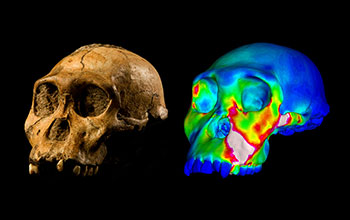Multimedia Gallery
Strains experienced during a simulated bite
The fossilized skull of Australopithecus sediba and a finite element model of its cranium depicting strains experienced during a simulated bite on its pre-molars. "Warm" colors indicate regions of high strain, "cool" colors indicate regions of low strain. A recent study found that A. sediba did not have the jaw and tooth structure necessary to exist on a steady diet of hard foods.
More about this image
A National Science Foundation (NSF)-supported study by an international team of researchers has found that Australopithecus sediba, a tiny prehuman species that lived about 2 million years ago in southern Africa, did not have the jaw and tooth structure necessary to exist on a steady diet of hard foods.
Researcher David Strait, a professor of anthropology at Washington University in St. Louis and leader of the research team, says most australopiths had adaptations in their jaws, teeth and faces that allowed them to process foods that were difficult to chew or crack open; for example, they were able to efficiently bite down on foods with very high force.
Justin Ledogar, a former graduate student of Straits and now a researcher at the University of New England in Australia, says "Australopithecus sediba is thought by some researchers to lie near the ancestry of Homo, the group to which our species belongs. Then we find that A. sediba had an important limitation on its ability to bite powerfully; if it had bitten as hard as possible on its molar teeth using the full force of its chewing muscles, it would have dislocated its jaw."
Published in the journal Nature Communications, the study describes biomechanical testing of a computer-based model of an A. sediba skull, recovered in 2008 from Malapa, a cave near Johannesburg, South Africa. The biomechanical methods used in the study are similar to those used by engineers to test whether planes, cars, machine parts or other mechanical devices are strong enough to avoid breaking during use.
A. sediba has been thought to be a possible ancestor or close relative of Homo. Australopiths appear in the fossil record about 4 million years ago. While they have some human traits, like the ability to walk upright on two legs, most of them lack other characteristically human features like a large brain, flat face with small jaw and teeth, and advanced tool use.
While the study does not directly address whether A. sediba is actually a close evolutionary relative of early Homo, it does provide further evidence that dietary changes were shaping the evolutionary paths of early humans. [Research supported by grants from the National Science Foundation (BCS 0725219, BCS 07-25183, BCS 07-25147, BCS 07-25141, BCS 07-25136, BCS 07-25126, BCS 07-25122, BCS 07-25078 and NSF DBI 07-43460.]
To learn more, see NSF press release 16-015, Early human ancestor lacked jaws of a nutcracker, study finds. (Date image taken: Unknown; date originally posted to NSF Multimedia Gallery: April 13, 2016)
Credit: Skull specimen MH1 by Brett Eloff, courtesy Lee Berger and University of the Witwatersrand
See other images like this on your iPhone or iPad download NSF Science Zone on the Apple App Store.
Images and other media in the National Science Foundation Multimedia Gallery are available for use in print and electronic material by NSF employees, members of the media, university staff, teachers and the general public. All media in the gallery are intended for personal, educational and nonprofit/non-commercial use only.
Images credited to the National Science Foundation, a federal agency, are in the public domain. The images were created by employees of the United States Government as part of their official duties or prepared by contractors as "works for hire" for NSF. You may freely use NSF-credited images and, at your discretion, credit NSF with a "Courtesy: National Science Foundation" notation.
Additional information about general usage can be found in Conditions.
Also Available:
Download the high-resolution JPG version of the image. (1.1 MB)
Use your mouse to right-click (Mac users may need to Ctrl-click) the link above and choose the option that will save the file or target to your computer.



